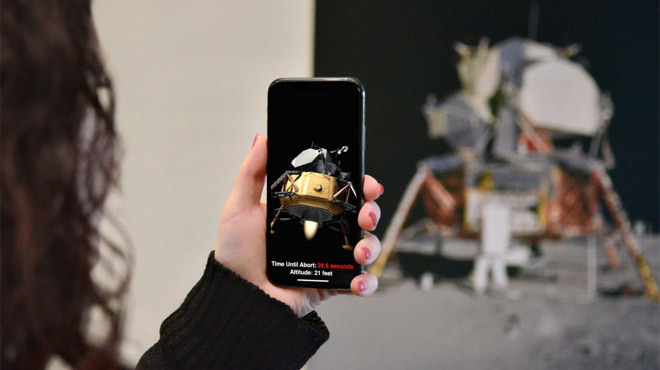Initial developer tests of ARKit 1.5 show off impressive vertical surface, image detection...
Developers have been testing out Apple's ARKit 1.5 since the refreshed augmented reality platform saw release with iOS 11.3 beta last week, and a few early projects offer a glimpse into the technology's ability to detect vertical surfaces, images and more.

Apple announced ARKit 1.5 in a preview of iOS 11.3 last week, touting refinements to the AR technology that will allow apps to recognize vertical and irregularly-shaped surfaces. With the new assets, developers can place virtual objects on walls, doors, odd-shaped tables and more, capabilities that make the platform more robust and immersive.
Over the proceeding days, a number of developers have taken a crack at leveraging ARKit 1.5's new features, to varying degrees of success.
For example, a brief presentation created by London-based mobile app development studio Ubicolor shows ARKit's ability to detect vertical surfaces, in this case a brick wall. The short clip shows a virtual object, a disc designed to roughly mimic the brick surface, overlaid on the wall, then twisted and pulled out to reveal hollow shaft.
Another attempt by iOS developer Mohammad Azam demonstrates ARKit's image recognition capabilities. Using ARKit 1.5, Azam was able to create a program that detects a movie poster, pulls up a clip or trailer of that film and presents the video in an overlaid window.
Similar AR posters are already in circulation, but often require an embedded QR code or specialized imagery to work. Apple's solution would allow production houses to benefit from augmented promotional material without altering original graphics.
Azam also applied the image recognition feature to book covers, which when properly configured and detected can act as triggers for the display of online e-commerce links.
Developer Tim Field created a module that shows iOS and ARKit detecting horizontal, vertical and irregular objects in real time.
Apple debuted ARKit in iOS 11 as a basis for its efforts in the augmented reality space. CEO Tim Cook has in past interviews extolled the virtues of AR, going so far as to say the technology has the potential to be as paradigm shifting as the App Store.
After an initial influx of ARKit apps, ranging from apps that position furniture within a user's house to games, the platform has hit a bit of a slow patch as developers look for new and novel ways to integrate the AR tech.

Apple announced ARKit 1.5 in a preview of iOS 11.3 last week, touting refinements to the AR technology that will allow apps to recognize vertical and irregularly-shaped surfaces. With the new assets, developers can place virtual objects on walls, doors, odd-shaped tables and more, capabilities that make the platform more robust and immersive.
Over the proceeding days, a number of developers have taken a crack at leveraging ARKit 1.5's new features, to varying degrees of success.
For example, a brief presentation created by London-based mobile app development studio Ubicolor shows ARKit's ability to detect vertical surfaces, in this case a brick wall. The short clip shows a virtual object, a disc designed to roughly mimic the brick surface, overlaid on the wall, then twisted and pulled out to reveal hollow shaft.
So I've been playing with the new ARKit wall detection today...what do you think?#arkit #madewitharkit #augmentedreality #iOS113 #arkit15 #ar #AugmentedReality pic.twitter.com/J9tj6sJf9S
-- Ubicolor (@ubicolorapps)
Another attempt by iOS developer Mohammad Azam demonstrates ARKit's image recognition capabilities. Using ARKit 1.5, Azam was able to create a program that detects a movie poster, pulls up a clip or trailer of that film and presents the video in an overlaid window.
Similar AR posters are already in circulation, but often require an embedded QR code or specialized imagery to work. Apple's solution would allow production houses to benefit from augmented promotional material without altering original graphics.
The Future of Movie Posters. ARKit 1.5 image detection and reference images. #ARKit #AugmentedReality pic.twitter.com/ruVxMCQtD3
-- azamsharp (@azamsharp)
Azam also applied the image recognition feature to book covers, which when properly configured and detected can act as triggers for the display of online e-commerce links.
Developer Tim Field created a module that shows iOS and ARKit detecting horizontal, vertical and irregular objects in real time.
New in iOS 11.3 - vertical & irregularly shaped surfaces with #ARKit pic.twitter.com/z54OuiIxuv
-- Tim Field (@nobbis)
Apple debuted ARKit in iOS 11 as a basis for its efforts in the augmented reality space. CEO Tim Cook has in past interviews extolled the virtues of AR, going so far as to say the technology has the potential to be as paradigm shifting as the App Store.
After an initial influx of ARKit apps, ranging from apps that position furniture within a user's house to games, the platform has hit a bit of a slow patch as developers look for new and novel ways to integrate the AR tech.

Comments
The poster scanning thing is like the Star Wars app, wherein I scan some specific poster from another screen and it puts Storm Troopers in the room as AR.
This tech is supposedly different though.
Using the cameras to detect objects, shapes and patterns for the AR software — that turns the whole real world into one big QR code.
However ARKit works better than Tango with the rear camera despite not having structured light showing just how very far you can go in deriving z-index information simply from VIO.
Yes, its true that with a completely featureless surface VIO will not work, but in reality such surfaces are not so common as to make AR useless as you suggest.
The power requirements and bulk of structured light, LIDAR etc. means that in the foreseeable future these will remain specialist tools (eg: for face detection as in the iPhone X) rather than general AR camera tools.
In the meantime VIO will just get better and better and once people have the glasses then there are some very useful general applications that will become possible.